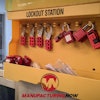(ATLANTA Sept. 15, 2011) The U.S.…
(ATLANTA
– Sept. 15, 2011) The U.S. Environmental
Protection Agency has added six new hazardous waste sites in the
Southeast that pose risks to human health and the environment to
the National Priorities List (NPL) of Superfund sites. EPA also
proposes adding two other sites to the list. Superfund is the
federal program that investigates and cleans up the most complex
uncontrolled or abandoned hazardous waste sites in the
country.
The following six sites in the Southeast have been added to the National Priorities List:
· Armstrong World Industries (ceiling tile manufacturer) in Macon, GA;
· Kerr-McGee Chemical Corp – Columbus (former pressure –treated railroad products manufacturer) in Columbus, MS;
· Red Panther Chemical Company (former pesticides formulation plant) in Clarksdale, MS;
· Horton Iron and Metal (former fertilizer manufacturer and metal salvage) in Wilmington, NC;
· US Finishing/Cone Mills (former textile operation) in Greenville, SC; and
· Alamo Contaminated Ground Water (contaminated ground water plume) in Alamo, TN;
The following two sites in the Southeast have been proposed to the National Priorities List:
· Southeastern Wood Preserving (former wood treating operation) in Canton, MS;
To date, 1,652 sites have been listed on the NPL. Of these sites, 350 sites have been cleaned up resulting in 1,302 sites currently on the NPL (including the 15 new sites added today). There are 62 proposed sites (including the 11 announced today) awaiting final agency action: 57 in the general Superfund section and five in the federal facilities section.
With all NPL sites, EPA tries to identify and locate the parties potentially responsible for the contamination to either fund the cleanup or conduct the cleanup with EPA oversight. For the newly listed sites without viable potentially responsible parties, EPA will fund the cleanup. Each Superfund site is investigated to determine the full extent of the contamination before cleanup is started. Therefore, it may be several years before significant cleanup funding is required for the sites.
Contaminated sites may be placed on the list through various mechanisms:
· Numeric ranking established by EPA’s Hazard Ranking System
· Designation by states or territories of one top-priority site
· Meeting all three of the following requirements:
- The Agency for Toxic Substances and Disease Registry (ATSDR) of the U.S. Department of Health and Human Services has issued a health advisory that recommends removing people from the site;
- EPA determines the site poses a significant threat to public health; and
- EPA anticipates it will be more cost-effective to use its remedial authority than to use its emergency removal authority to respond to the site.
Federal Register notices and supporting documents for the final and proposed sites: http://www.epa.gov/superfund/sites/npl/current.htm
Information about how a site is listed on the
NPL: http://www.epa.gov/superfund/programs/npl_hrs/nplon.htm
Superfund sites in local communities: http://www.epa.gov/superfund/sites/index.htm






















